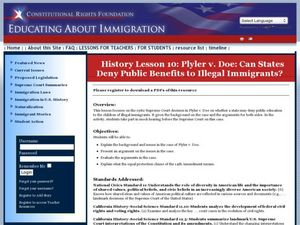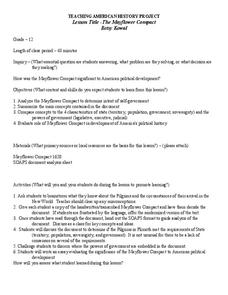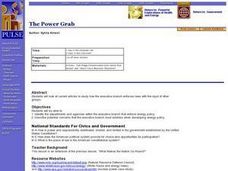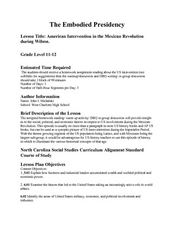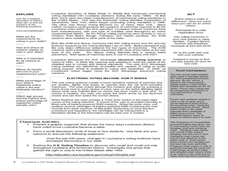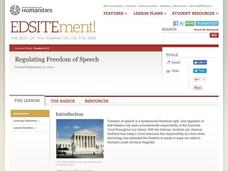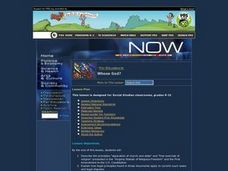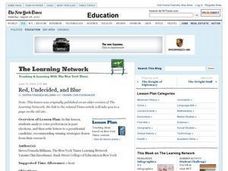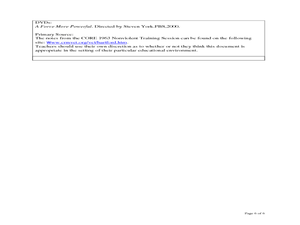Curated OER
History Lesson 10: Plyler v. Doe: Can States Deny Public Benefits to Illegal Immigrants?
Students consider the rights of illegal immigrants. In this illegal immigration lesson, students analyze the Supreme Court case Plyler v. Doe and determine whether illegal immigrants should have access to public benefits. Students...
Curated OER
Women of the Twenties and The Great Gatsby
Students research social elements of the 1920s. In this persuasive writing lesson, students make comparisons between women of the 1920s and women in the 21st century. They work in small groups to discuss the women in The Great Gatsby,...
Curated OER
The Mayflower Compact
Twelfth graders discover the ideas of our government by reading the Mayflower Compact. In this U.S. Government lesson, 12th graders identify the main ideas of the Mayflower Compact, how it came to be and who was affected the most by...
Curated OER
Creating a Classroom Belief Statement
Fourth graders cooperatively develop a classroom belief statement that serves as their classroom constitution. Each student is involved in the creation of the statement. Each group presents their belief statement to the class.
Curated OER
Government: The Power Grab
Students are able to identify the departments and agencies within the executive branch that enforce energy policy. They are able to describe potential concerns that the executive branch must address when developing energy policy.
Curated OER
Government: The Power of Persuasion
High schoolers are able to define and identify a type of interest group. They are able to describe some strategies used by interest group. Students are able to identify the postive and negative aspects of interest groups.
Curated OER
What is an Iron Triangle?
Students discuss how interest groups, congress and the executive branch play a role in policy making to make up the Iron Triangle. They list the three points of the Iron Triangle and explain the role they have on public policy. Students...
Curated OER
Looking at Portraits: Thomas Jefferson
Students examine works of art that have influenced images of our founding fathers still in use today, and discuss influences from antiquity on Houdon's sculpture.
Curated OER
What Can We Learn from Primary-Source Documents? Lesson 2
Students extrapolate information from primary-source documents. They read and research to create a whole-class timeline of events leading up to 1867 and Confederation.
Curated OER
Freedom and Dignity Project
Eleventh graders explore slavery and the civil war. In groups, 11th graders discuss and slavery and identify reasons for its beginning. In groups, they role-play a character for a talk show. Students determine what slavery was like in...
Curated OER
The Embodied Presidency Wilson
Young scholars take a closer look at U.S. intervention in Mexico. In this 20th century history lesson, students examine primary documents to consider why the United States entered the Mexican War and then write DBQ essays on the topic.
Curated OER
Reporting on the 1920s
Use this roaring 1920s history lesson to have young writers research primary and secondary sources. They use their research to examine the events or famous public figures of the time period. Next, they imagine they're in the 1920s and...
Curated OER
How We Vote
Students fill in a graphic organizer and discuss the struggles in groups about the history of voting in Louisiana. Students also explore a voting timeline to see who could and could not vote before and after 1850.
Curated OER
"Let us Reason Together" Lyndon Johnson, Master Legislator
Students explore the contributions of Lyndon B. Johnson. In this congress lesson, students listen to their instructor lecture on the prowess of Lyndon B. Johnson's legislative skills. Students respond to discussion questions connected to...
Curated OER
George Washington: The Living Symbol
Learners discuss George Washington's life and how he became a symbol of this nation. They categorize various images of Washington into the various roles he plays.
Curated OER
Jamestown in Context: The Colonization of North America
Students analyze the significance of Jamestown in the broader picture of colonization and analyze a historical document to determine the effects of previous explorations on the expectations of the Jamestown colonizers
Curated OER
California Gold Rush
Students discover the people who lived in California before and after the gold rush. They use primary source documents to identify how the finding of gold changed the area. They also discover the discrimation that was present during the...
Curated OER
Genealogy Research
Personalize history through genealogy. Get your scholars examining their family's past by utilizing resources at your local genealogical society. Learners complete family pedigree charts and choose to do one of the following: research...
Curated OER
Genealogy Research
Students explore history is not as a listing of dates, wars, and leaders but as the story of real people whose lives were impacted by the events of their time. They complete a pedigree chart and tape record a family member.
Curated OER
Regulating Freedom of Speech
Pupils examine the nature and limits of the Constitutional right to freedom of speech. They read and analyze the First Amendment, discuss various case studies, and research and record their own opinion on discussion questions.
Curated OER
Who Led the South?
Eighth graders explore the role of Jefferson Davis and his leadership of the Confederacy during the Civil War. They examine the command system used in the Confederacy and analyze the effectiveness of the command system.
Curated OER
Whose God?
Students investigate religious freedom in the U.S. They watch and discuss a Bill Moyers NOW video, take a Freedom of Religion quiz, write an essay, and participate in a mock trial and debate.
Curated OER
Red, Undecided, and Blue
Students analyze voter preferences in past elections, and then write letters to a presidential candidate, recommending winning strategies drawn from their research.
Curated OER
ON BECOMING A NONVIOLENT WARRIOR
Students examine the concept of non-violent social change. In this lesson on social change, students research and role play to demonstrate ways in which this might be accomplished while making connections to various events in history.


